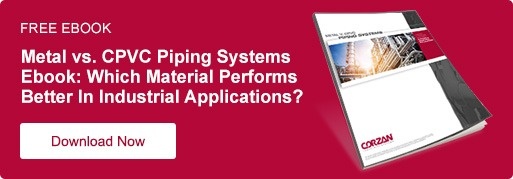WHICH MATERIAL PROVIDES THE BEST LIFETIME VALUE FOR INDUSTRIAL PIPING APPLICATIONS?
 Savvy specifiers know that when selecting a piping system, it's not just the purchase price that matters when choosing a product that's designed for long-term performance.
Savvy specifiers know that when selecting a piping system, it's not just the purchase price that matters when choosing a product that's designed for long-term performance.
When evaluating an industrial piping system, this is certainly the case.
The key to getting the best value from a piping system today, tomorrow and beyond typically requires a lifecycle cost analysis tailored to your specific plant. This analysis should reflect your plant's fluid temperatures, line pressures, and chemical environments, among other things.
What to Consider as Part of a Lifecycle Cost Analysis
For each material you're considering, conduct a lifecycle cost analysis by calculating the following:
INSTALLATION COSTS: Don't focus solely on direct material costs. Indirect costs, such as labor and other installation expenses can combine for more than half of your total investment.
MAINTENANCE COSTS: Consider the cost to maintain the system and how maintenance affects productivity, downtime and lost opportunity.
EXPECTED SERVICE LIFE: How long should the system last before a total repipe will become financially and operationally necessary.
Also, account for the cost of lost opportunity during installation or maintenance if a full or partial system shutdown is required (scheduled shutdowns notwithstanding).
Comparing Metal, Plastic and Dual Laminate Piping Materials
Depending on the demands and environment of the operation, you may consider dozens of materials. On the low end of the cost spectrum are polyvinyl chloride (PVC), chlorinated polyvinyl chloride (CPVC) and carbon steel. On the opposite extreme, there are high-performance metals such as nickel, titanium, zirconium and alloys. In between are combination systems such as steel lined with rubber, polyvinylidene fluoride (PVDF) or glass.
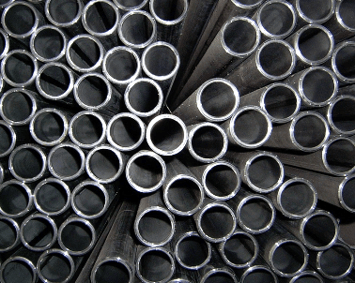 METALS: Historically, metals have dominated the industrial piping market, largely because there is trust in what's familiar and they've been around the longest.
METALS: Historically, metals have dominated the industrial piping market, largely because there is trust in what's familiar and they've been around the longest.
In general, metal piping offers:
- High pressure-bearing capabilities.
- Relatively consistent pressure-bearing capabilities at elevated temperatures.
- Rigidity that allows hangers to be spaced farther apart to save on installation costs.
At the same time, metal piping poses numerous disadvantages. Specifically it is:
- Vulnerable to internal and external corrosion. Certain substances may cause metal to corrode from within, while elements such as salt in the air or low pH levels in the ground (for underground applications) can prompt external corrosion. Even titanium, which generally resists corrosion, is susceptible to degradation in certain environments.
- Subject to flow-restricting scale build-up, which increases pressure drop and can contaminate the process.
- Heavy and more expensive to install, both in material and labor cost.
- A poor insulator causing pipes to sweat more when handling cold fluids, pose a burn hazard when transporting hot fluids, and limit energy efficiency, all of which create a need to add costly insulation.
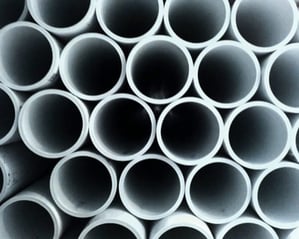 PLASTICS: Today, many different plastics successfully serve in industrial environments.
PLASTICS: Today, many different plastics successfully serve in industrial environments.
In general, one of the greatest benefits to plastic pipe is corrosion resistance. Various types of plastic piping can be buried in alkaline or acidic soils without requiring any paint or special coating. And plastics containing TiO2 for ultraviolet protection strongly resist weather.
Additionally, most plastic pipe is not susceptible to scaling, so plastic piping systems maintain their full fluid-handling capability throughout their entire service life. This means it's often possible to downsize the diameter of the pipe when converting from metal, reducing material costs, and to opt for smaller pumps, saving energy.
It is important to note, various plastics differ in cost and capabilities. For example, PVC offers significant economic advantages but can't handle high-temperature applications.
CPVC, on the other hand, provides superior chemical resistance, as well as a high heat distortion temperature because large chlorine atoms surround the carbon backbone, protecting it like armor plating. Because of this, CPVC has grown in popularity in both corrosive and high-temperature applications.
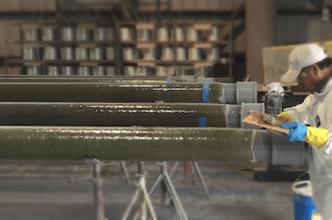
Dual Laminates: In recent years, manufacturers have been able to increase CPVC's temperature and pressure-bearing capabilities by wrapping it with fiberglass.
The major disadvantage of plastic-lined, dual laminate pipe is cost. In addition, it requires a difficult labor-intensive joining process. And, any break that occurs in the lining can become a source for future pipe failures.
The Case for CPVC
Of course, cost is always an overriding factor in industrial pipe selection. An authoritative study documented that when accounting for direct and indirect costs—material, labor, maintenance, productivity, etc.—CPVC was the bottom-line best choice. It's nearest rival, strictly from a total-installed cost perspective, was carbon steel.
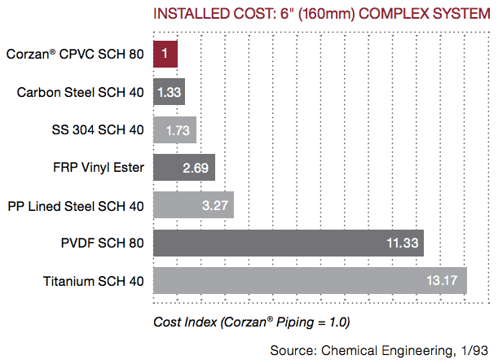
Thanks to its high heat distortion temperature, chemical inertness and outstanding mechanical, dielectric, flame and smoke properties, CPVC can likely serve a role in nearly any chemical plant today. Indeed, wherever corrosion resistance and mechanical strength are crucial, consider CPVC.
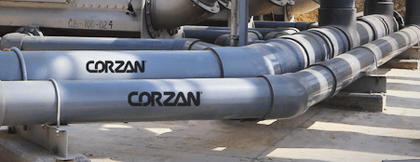 Applications also extend beyond processing operations. CPVC is often the most effective choice for cleaning systems involving high temperatures, harsh cleaning agents or high purity standards.
Applications also extend beyond processing operations. CPVC is often the most effective choice for cleaning systems involving high temperatures, harsh cleaning agents or high purity standards.
CPVC stands up to chemicals that commonly cause process leaks, flow restrictions, and ultimately premature failure in metal systems. It can also withstand mineral acids, bases, salts, or aliphatic hydrocarbons.
However, it is important to keep in mind that not all CPVC compounds on the market perform similarly. You can gauge how well specific CPVC piping will perform from its cell class, which is defined by ASTM D1784 and certified by NSF International. There are now two cell classifications—23447 and 24448.
A majority of CPVC pipe falls into the standard 23447 level. However, industrial pipe systems that meet the 24448 classification—all of which are made from second-generation CPVC formulations—exhibit 3x the impact strength of standard CPVC, resulting in fewer breaks and fractures, a lower scrap rate and easier cutting. It also provides a higher heat distortion temperature—230ºF compared to 212ºF—which translates into a lower probability of sagging or bending.
Additionally, second-generation CPVC systems uniquely feature fittings made from pressure-rated compounds. The fitting compounds carry the same pressure-rating classes as the pipe compound. The fittings provide improved creep resistance and can better withstand long-term, high-temperature hydrostatic pressure.
Choose Wisely
An analysis of piping should go beyond initial price to consider lifecycle costs. The challenge is choosing a system that meets the performance and budget criteria at installation and over the long term.
Do your homework and consider all aspects of a repiping project. Many plants settle for the familiar without fully exploring the benefits and opportunities available with alternative materials.
Need Technical, Specification or Engineering Support?
From spec writing to installation, our team of industrial and engineering experts are here to provide the advice, information and training needed to select and integrate the best piping solution for your application. Request a free consultation.


